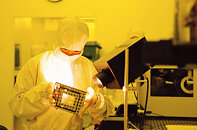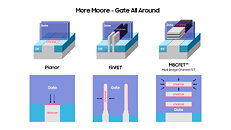T0@st
News Editor
- Joined
- Mar 7, 2023
- Messages
- 2,938 (3.81/day)
- Location
- South East, UK
| System Name | The TPU Typewriter |
|---|---|
| Processor | AMD Ryzen 5 5600 (non-X) |
| Motherboard | GIGABYTE B550M DS3H Micro ATX |
| Cooling | DeepCool AS500 |
| Memory | Kingston Fury Renegade RGB 32 GB (2 x 16 GB) DDR4-3600 CL16 |
| Video Card(s) | PowerColor Radeon RX 7800 XT 16 GB Hellhound OC |
| Storage | Samsung 980 Pro 1 TB M.2-2280 PCIe 4.0 X4 NVME SSD |
| Display(s) | Lenovo Legion Y27q-20 27" QHD IPS monitor |
| Case | GameMax Spark M-ATX (re-badged Jonsbo D30) |
| Audio Device(s) | FiiO K7 Desktop DAC/Amp + Philips Fidelio X3 headphones, or ARTTI T10 Planar IEMs |
| Power Supply | ADATA XPG CORE Reactor 650 W 80+ Gold ATX |
| Mouse | Roccat Kone Pro Air |
| Keyboard | Cooler Master MasterKeys Pro L |
| Software | Windows 10 64-bit Home Edition |
Samsung and ARM announced a collaborative project last week—the partners are aiming to deliver an "optimized next generation Arm Cortex -X CPU" developed on the latest Gate-All-Around (GAA) process technology. Semiconductor industry watchdogs believe that Samsung Foundry's 3 nm GAA process did not meet sales expectations—reports suggest that many clients decided to pursue advanced three nanometer service options chez TSMC. The South Korean multinational manufacturing conglomerate is setting its sights forward—with an in-progress SF2 GAAFET process in the pipeline—industry insiders reckon that Samsung leadership is hoping to score a major victory within this next-gen market segment.
Lately, important industry figures have been hyping up Backside Power Supply Delivery Network (BSPDN) technology—recent Intel Foundry Services (IFS) press material lays claim to several technological innovations. A prime example being an ambitious five-nodes-in-four-years (5N4Y) process roadmap that: "remains on track and will deliver the industry's first backside power solution." A Chosun Business report proposes that Samsung is working on Backside Power Supply designs—a possible "game changer" when combined with in-house 2 nm SF2 GAAFET. Early experiments, allegedly, involving two unidentified ARM cores have exceeded expectations—according to Chosun's sources, engineers were able to: "reduce the chip area by 10% and 19%, respectively, and succeeded in improving chip performance and frequency efficiency to a single-digit level." Samsung Foundry could be adjusting its mass production timetables, based on freshly reported technological breakthroughs—SF2 GAAFET + BSPDN designs could arrive before the original targeted year of 2027. Prior to the latest developments, Samsung's BSPDN tech was linked to a futuristic 1.7 nm line.



View at TechPowerUp Main Site | Source
Lately, important industry figures have been hyping up Backside Power Supply Delivery Network (BSPDN) technology—recent Intel Foundry Services (IFS) press material lays claim to several technological innovations. A prime example being an ambitious five-nodes-in-four-years (5N4Y) process roadmap that: "remains on track and will deliver the industry's first backside power solution." A Chosun Business report proposes that Samsung is working on Backside Power Supply designs—a possible "game changer" when combined with in-house 2 nm SF2 GAAFET. Early experiments, allegedly, involving two unidentified ARM cores have exceeded expectations—according to Chosun's sources, engineers were able to: "reduce the chip area by 10% and 19%, respectively, and succeeded in improving chip performance and frequency efficiency to a single-digit level." Samsung Foundry could be adjusting its mass production timetables, based on freshly reported technological breakthroughs—SF2 GAAFET + BSPDN designs could arrive before the original targeted year of 2027. Prior to the latest developments, Samsung's BSPDN tech was linked to a futuristic 1.7 nm line.



View at TechPowerUp Main Site | Source
